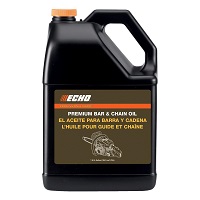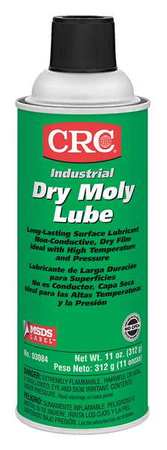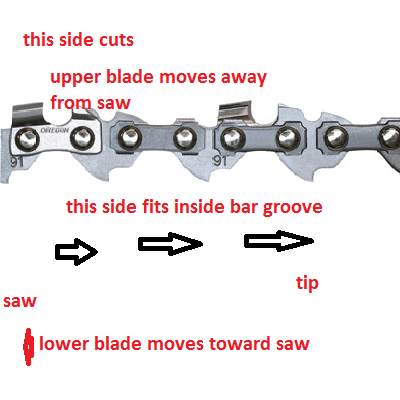I was watching my neighbor try UN, successfully to use a chain saw to cut a few small trees on his property, he was not making much progress,
with a chain saw he recently purchased.
he called me over and said the old ,original chain saw blade had snapped,
and he had bought and replaced it with a new bladed chain, but
" the new blade, he purchased .. was obviously crappy quality, as it would barely cut at all"
If you have purchased a new tool your not familiar with it really pays to read through the instruction book and pay attention to the details, and look over the diagrams very carefully
you may think that if you know the chain saw brand and model that theres a chart showing the correct blade...thats not always handy at many hardware stores
we all make mistakes and learn from those mistakes , but its a whole lot easier and cheaper to read through the instruction manual, than to screw up a new tool
most chain saws will have the proper chain length and pitch printed on the bar the chain runs around
ONCE YOU KNOW EXACTLY WHAT CHAIN FITS YOUR SAW WRITE THE INFO DOWN
BOTH ON THE SAW AND SOME PLACE IN YOUR TOOL BOX, in fact its a good idea to buy two replacement chains, on most trips, so you don,t need to run to the store if one fails
I TRY TO KEEP THE PART NUMBER AND THE FLAP FROM THE EMPTY REPLACEMENT CHAIN BOX FOR FUTURE REFERENCE
youll generally get longer life with less issues if you use the 40:1 fuel and take the time to fill the chain lube tank before every use, soak the chain and bar down every hour or so with MOLY spray also makes the chain last longer and cut better.
https://www.zoro.com/crc-dry-moly-l...VDXd-Ch1HPQtoEAQYBCABEgIjC_D_BwE&gclsrc=aw.ds
let the chain lube run low on lube and it wears very rapidly
I looked at the chainsaw and quickly noticed the oil tank for chain lube was completely empty,
I got a quart of chain& bar oil from the shop and filled his saws resevior ,
the chain and bar will wear out very quickly if you run dry on chain and bar oil

so I filled it and explained that it was critical that the oil flow to the chain remain constant and that he needed to keep it full, and that soaking the saws chain down, every time he refilled the fuel tank with a good moly spray noticeably helps extend chain durability.

then I noticed his major problem.....his chain was installed facing the wrong direction
yes it will and can be installed wrong simply flip it over and the cutting blade tips face the wrong direction....
this is an easy to make mistake,
if your totally un-familiar with chain saw blade replacement


READ THE LINKED INFO
https://www.stihlusa.com/information/how-to-guides/saw-chain-identification/
STIHL uses a Marketing Number System in addition to the part number. This allows easy identification of any chain. For example, chain with a Marketing Number of 33 RS3:
Pitch Gauge Type Shape Special
3 3 R S 3
3/8" .050" STIHL RAPID™ Super Single-Humped Drive Link

Distance between three rivets
divided by two as shown.
Pitch (Marked on cutter)
1 = 1/4"
2 = .325"
3 = 3/8"
4 = .404"
6 = STIHL PICCO™ (3/8" Extended)
7 = STIHL PICCO™ (1/4" Extended)
Cutter Type
R = STIHL RAPID™
P = STIHL PICCO™
Cutter Shape
S = Super (Full Chisel)
M = Micro™ (Semi Chisel)
D = Duro (Carbide Tip)
R = Rescue (RDR chain, especially designed
for MS 460 R STIHL Magnum® Rescue
carbide segment)

Gauge (on drive link)
1 = .043" (1.1 mm)
3 = .050" (1.3 mm)
5 = .058" (1.5 mm)
6 = .063" (1.6 mm)
0 = .080" (2.0 mm) Harvester
Chain Only
Special
1 = Triple-humped Tie Strap
on PM chain
2 = Triple-humped Tie Strap
on RM chain
3 = Single-Humped Drive Link
F = Full Skip
H = Semi Skip (Half-Skip) or
Harvester (i.e. on .404" RMH)
K = Classic Cutter Design
L = Square Ground Chisel
M = Mini
MM = Mini Micro™
N = Narrow (PMN)
S = Special
Number of Drive Links in Reels
Type 100' Reel
1/4"
3/8" STIHL PICCO™
.325"
3/8"
.404" 2400
1640
1840
1640
1480
ANSI B175.1 Chainsaw Kickback Standard
STIHL’s green and yellow color code system serves to identify STIHL bars and chains with different kickback reduction characteristics. Green (go) marks those products which are designed to reduce the risk of kickback injury and comply with the ANSI B175.1 kickback standard. STIHL’s low-kickback chain features a green tie strap that identifies each loop as “low-kickback” chain that meets the ANSI standard. Recommended for both the experienced and inexperienced chainsaw user. Yellow (caution) marks products with increased risk of kickback injury. They are for use only by persons with extraordinary cutting needs and experience and specialized training in dealing with kickback conditions.
http://www.ereplacementparts.com/article/1507/Chainsaw_Chain_Measurements_Sizes_and_Types.html
https://www.stihlusa.com/WebContent/CMSFileLibrary/downloads/Chain-Saw-Comparison-Chart.pdf
YES IT IS POSSIBLE TO INSTALL THE CUTTING CHAIN FACING THE WRONG DIRECTION

If your new chain is is not cutting, chances are that you put it on backwards. Remember, when holding the chainsaw, the cutting portion of the blade should be facing away from you, traveling from the back of the chainsaw to the front tip of the chainsaw. As the blade rounds the tip of the bar, the cutting part of the blade will come in contact with the material you are cutting.
with a chain saw he recently purchased.
he called me over and said the old ,original chain saw blade had snapped,
and he had bought and replaced it with a new bladed chain, but
" the new blade, he purchased .. was obviously crappy quality, as it would barely cut at all"
If you have purchased a new tool your not familiar with it really pays to read through the instruction book and pay attention to the details, and look over the diagrams very carefully
you may think that if you know the chain saw brand and model that theres a chart showing the correct blade...thats not always handy at many hardware stores
we all make mistakes and learn from those mistakes , but its a whole lot easier and cheaper to read through the instruction manual, than to screw up a new tool
most chain saws will have the proper chain length and pitch printed on the bar the chain runs around
ONCE YOU KNOW EXACTLY WHAT CHAIN FITS YOUR SAW WRITE THE INFO DOWN
BOTH ON THE SAW AND SOME PLACE IN YOUR TOOL BOX, in fact its a good idea to buy two replacement chains, on most trips, so you don,t need to run to the store if one fails
I TRY TO KEEP THE PART NUMBER AND THE FLAP FROM THE EMPTY REPLACEMENT CHAIN BOX FOR FUTURE REFERENCE
youll generally get longer life with less issues if you use the 40:1 fuel and take the time to fill the chain lube tank before every use, soak the chain and bar down every hour or so with MOLY spray also makes the chain last longer and cut better.
https://www.zoro.com/crc-dry-moly-l...VDXd-Ch1HPQtoEAQYBCABEgIjC_D_BwE&gclsrc=aw.ds
let the chain lube run low on lube and it wears very rapidly
I looked at the chainsaw and quickly noticed the oil tank for chain lube was completely empty,
I got a quart of chain& bar oil from the shop and filled his saws resevior ,
the chain and bar will wear out very quickly if you run dry on chain and bar oil

so I filled it and explained that it was critical that the oil flow to the chain remain constant and that he needed to keep it full, and that soaking the saws chain down, every time he refilled the fuel tank with a good moly spray noticeably helps extend chain durability.
then I noticed his major problem.....his chain was installed facing the wrong direction
yes it will and can be installed wrong simply flip it over and the cutting blade tips face the wrong direction....
this is an easy to make mistake,
if your totally un-familiar with chain saw blade replacement


READ THE LINKED INFO
https://www.stihlusa.com/information/how-to-guides/saw-chain-identification/
STIHL uses a Marketing Number System in addition to the part number. This allows easy identification of any chain. For example, chain with a Marketing Number of 33 RS3:
Pitch Gauge Type Shape Special
3 3 R S 3
3/8" .050" STIHL RAPID™ Super Single-Humped Drive Link

Distance between three rivets
divided by two as shown.
Pitch (Marked on cutter)
1 = 1/4"
2 = .325"
3 = 3/8"
4 = .404"
6 = STIHL PICCO™ (3/8" Extended)
7 = STIHL PICCO™ (1/4" Extended)
Cutter Type
R = STIHL RAPID™
P = STIHL PICCO™
Cutter Shape
S = Super (Full Chisel)
M = Micro™ (Semi Chisel)
D = Duro (Carbide Tip)
R = Rescue (RDR chain, especially designed
for MS 460 R STIHL Magnum® Rescue
carbide segment)

Gauge (on drive link)
1 = .043" (1.1 mm)
3 = .050" (1.3 mm)
5 = .058" (1.5 mm)
6 = .063" (1.6 mm)
0 = .080" (2.0 mm) Harvester
Chain Only
Special
1 = Triple-humped Tie Strap
on PM chain
2 = Triple-humped Tie Strap
on RM chain
3 = Single-Humped Drive Link
F = Full Skip
H = Semi Skip (Half-Skip) or
Harvester (i.e. on .404" RMH)
K = Classic Cutter Design
L = Square Ground Chisel
M = Mini
MM = Mini Micro™
N = Narrow (PMN)
S = Special
Number of Drive Links in Reels
Type 100' Reel
1/4"
3/8" STIHL PICCO™
.325"
3/8"
.404" 2400
1640
1840
1640
1480
ANSI B175.1 Chainsaw Kickback Standard
STIHL’s green and yellow color code system serves to identify STIHL bars and chains with different kickback reduction characteristics. Green (go) marks those products which are designed to reduce the risk of kickback injury and comply with the ANSI B175.1 kickback standard. STIHL’s low-kickback chain features a green tie strap that identifies each loop as “low-kickback” chain that meets the ANSI standard. Recommended for both the experienced and inexperienced chainsaw user. Yellow (caution) marks products with increased risk of kickback injury. They are for use only by persons with extraordinary cutting needs and experience and specialized training in dealing with kickback conditions.
http://www.ereplacementparts.com/article/1507/Chainsaw_Chain_Measurements_Sizes_and_Types.html
https://www.stihlusa.com/WebContent/CMSFileLibrary/downloads/Chain-Saw-Comparison-Chart.pdf
YES IT IS POSSIBLE TO INSTALL THE CUTTING CHAIN FACING THE WRONG DIRECTION

If your new chain is is not cutting, chances are that you put it on backwards. Remember, when holding the chainsaw, the cutting portion of the blade should be facing away from you, traveling from the back of the chainsaw to the front tip of the chainsaw. As the blade rounds the tip of the bar, the cutting part of the blade will come in contact with the material you are cutting.
Last edited:
